This past weekend was busy with a magnificent wedding, and to top the weekend off, a friend stopped by to show me her great-grandmother’s hand embroidered wedding dress. I thought I’d share some photos of it with you – it’s a magnificent dress from a by-gone era!
Made from a gorgeous silk Crepe de Chine, the dress and “court train” are completely hand embroidered in silk perle with a pattern of chrysanthemums, ribbons, and shamrocks. The shoulders and sleeves of the dress are made of embroidered tulle, and the waste is accented with a rhinestone and bead bow.
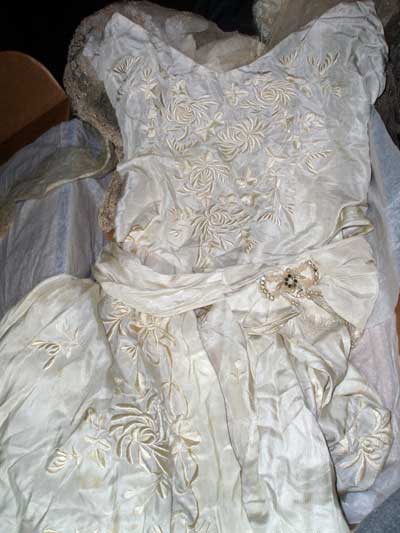
The dress, unfortunately, was not carefully packaged or preserved over the last century, so it shows some serious marks of deterioration. The tulle on the shoulders and sleeves has turned a dark brown, and although feeling somewhat brittle in some places, it can still be gently handled. The lining of the dress is decaying in shreds, but the silk crepe of the dress itself is still in lovely shape (despite discoloration and some spotting that looks like rust). The embroidery is immaculate, with the exception of an occasionally broken thread here and there.
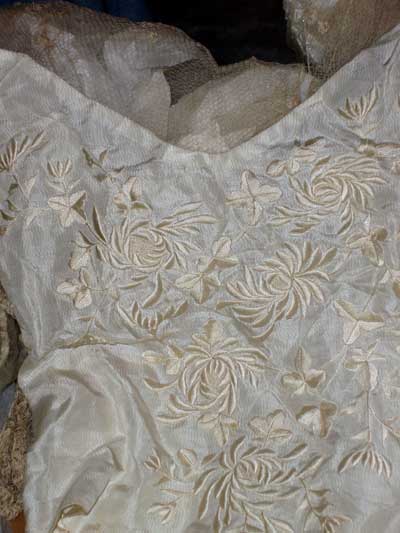
The bodice of the dress is covered with an abundance of embroidered chrysanthemums and shamrocks. The lustre of the silk threads is amazing – only silk thread could withstand the test and ravages of time and still look practically brand new!
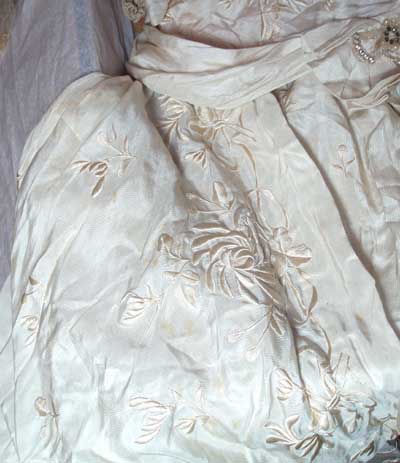
Here, you can see the waste sash and the edge of the train running down the length of the skirt. The train, which is relatively small by today’s standards of fancy trains, is made from the same fabric as the dress. It is relatively narrow and falls not too much longer than the length of the gown. The sides of the train wrap just barely to the front of the dress, so that the beautiful embroidery that adorns the edges of the train can be seen from the front and then down across the lower edge where it trails on the ground.
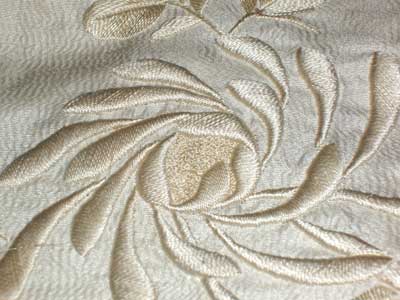
The large chrysanthemums are made of sweeping petals, embroidered in satin stitch, and their centers are embroidered with French knots.
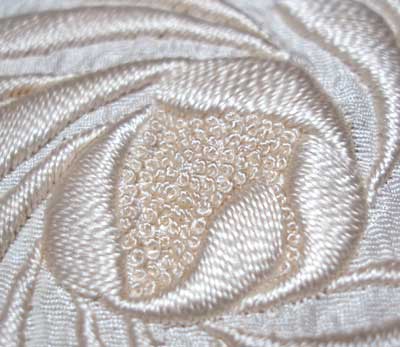
In the close-up above, you can see that the clusters of French knots and the satin stitching are still in perfect shape – absolutely lovely!
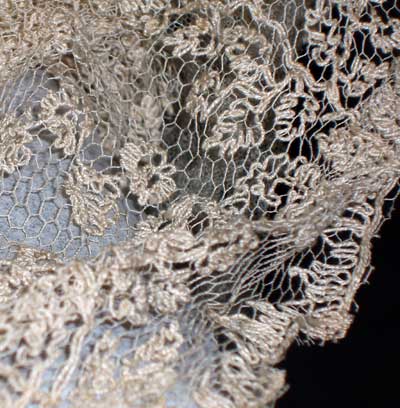
The tulle that forms the caps of the sleeves is browned with age, but the embroidery on the tulle is still in excellent shape, and though the tulle seems somewhat brittle, it is actually quite soft. I love the leaf designs on the edge of this sleeve cap.
This particular tulle forms a kind of cap at the top of the sleeves – it is a larger-holed tulle in the typical hexagon shape. The sleeve itself is made from a very fine tulle which is slightly more brittle and had tiny holes, making it a bit more opaque. At the edge of the long tulle sleeves is a ruffle made of a diamond-shape netting, delicately embroidered:
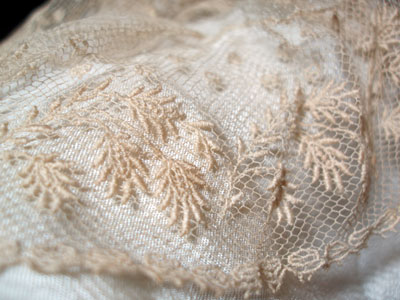
I am not certain if this particular lace that forms the ruffle at the edge of the sleeves is hand embroidered or not. The little flower designs are made of what looks like bullion knots, but they may actually be satin stitch (or overcast stitching). The very edge is lined with scallops topped with a little picot.
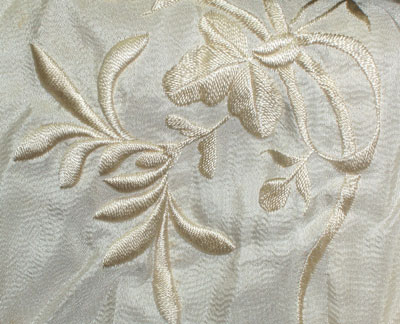
This is a closer shot of one of the smaller embroidered chrysanthemums, ribbons, and shamrock. It’s beautiful from the front, but what’s amazing is that it is equally beautiful from the back:
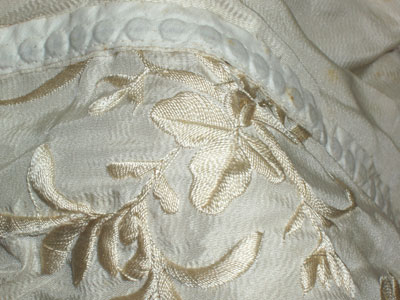
Do you see the row of “dots” at the top of the embroidery? That is a strip of tiny weights sewn to the edge of the train.
The dress is stunning – and so light and airy, despite what looks like a heavy embroidery design. The whole dress is petit in size – I would say it’s equivalent to about a size 4 – and holding it up to me, height-wise, the length would fall about to my mid-calf – and I’m only 5′ 3″. The bride was certainly a petit little thing. The article accompanying the dress indicated that her veil was adorned with an orange-blossom crown and she carried a bouquet of roses.







C'est une merveilleuse robe, merci pour le partage.
This is just "Beautiful." When I see such things from another period in time, my mind begins to wonder about the history of such a wonderful piece. The bride and groom…what were they like? How did they meet, how long married, their life together? Our stories about our lives…some are lost and some are preserved in our memories or passed along to us as in this beautiful wedding dress.
Annie in Michigan
Has your friend considered donating (or even permanent loaning) the dress to an institution that would/could take care of it? Such as the Smithsonian or even the DAR (who have a fantastic textiles collection in their DC museum)? The dress is certainly worthy of curatorial examination and ministrations. What a beautiful piece of history.
The dress is stunning! Thanks for sharing it with us.
What an amazing heirloom! I wonder how long it took to make…….what the maker thought about while working on it…..was it the dress for her wedding….did she dream of her husband to be…..was it her daughter's dress and was she remembering her as a baby? So much love went into this dress! I re-worked a dress for my daughter's wedding…..altering sleeves and adding a multitude of missing beads while I re-couperated from surgery. Oh the memories of her and the dreams I had for her. Thank you for sharing this with us.
Stunning! I am working on my first baptism dress and only hope it will look as beautiful when it's done, much less years later. (Also, I think you mean "waist", not waste.)
Wow! I was most impressed with the embroideries on the tulle. Have you ever tried this?
Hi Mary, What a gorgeous dress! And great photos of a gorgeous dress. Not to dispute your belief that the dress is embroidered with Chrysanthemums and Shamrocks, I looked and saw Chrysanthemums and Ivy. And really, when you think about it, ivy is a symbol of love and marriage, of life and desire. It is also a symbol of forever true. You, of course, have the dress in front of you and I am only looking at the pictures. So tell me what do you think? I haven't done any research as yet on the meaning, if any, of the chrysanthemums. Thanks for such an interesting entry.
That's lovely! The satin stitching is *incredible*!!
It's a shame it's deteriorating. I wonder if removing the tulle and lining would preserve the rest of the dress?
Beautiful! I've only dreamed of doing satin stitching that well. As far as preserving it, I *think* what would need to be done is make a whole new lining, and tack the dress to it, so that the lining is evenly supporting the weight of the dress. Similar for the tulle parts. Or have a box large enough to lay the dress out unfolded. Thanks for sharing – I wish I had such family treasures!
do you have a picture of the bride wearing the dress?
That is absolutely gorgeous 😮 so much work put into it!
Isn't it utterly beautiful…so much work must havc gone into this!
Was it made within a family, a mother making it as a heirloom for her daughter? Do you know anything about the history?
Wow that is breathtaking. All I can imagine now is someone sitting sewing their wedding dress for months on end! It's a good thing she was so petit otherwise it would have taken even longer. It makes today's manufactured dresses seem so dull.
Dear Mary…your website continues to inspire me ! My own wedding dress (Nov. 1961) is in much the same condition as this one you display and I'm more and more motivated to refurbish it as best I can in hopes that my granddaughter or ? will one day want to wear it. You are inspiring me, AGAIN, to tackle projects I would otherwise shrink from. Thanks so much. Gramma's wedding dress is now coming out of the drawer, into the light of a new day and hopefully, a new life! God love you!…
Judy in Pittsburgh.
Just plain ol' lovely! Thanks for taking & posting the pix! Very inspiring! Cheers, Julie
That dress is absolutely beautiful. What a family treasure. Thanks for sharing the photos.
How beautiful! With regards to the size, I know that in the 1920s, wedding dresses were not usually floor-length but fell to about mid-calf; I wonder if the same was true for the year this dress was worn?
I would LOVE to see what this looks like on someone. 🙂 When I was younger, I always wanted to wear my grandmother's wedding dress from the early 40's. It unfortunately had a big stain that could not be removed. Such gorgeous dresses were made in the early 1900's!!!
It is so beautiful… And how much work had to be done to stitch such a dress.. Incredible…
I think when its calf length its called Ballerina length. Looking at a few old photo's I have of the early part of the 20th century, they are nearly all this length though not as elaborate.
Jan from FNQ Australia
In times past, such vintage wedding dresses used great, billowing amounts of fabric, lace, bead work, hand worked embroidered bodices and lovely trains.
Fabric was not so costly and a bride could enjoy yards and yards of flowing, layered fabrics to make her feel like the loveliest of fairy princesses on her big day.
You'll be hard pressed to find this quality of hand work in today's wedding dresses – at any price.
Many thanks for sharing!
Thank you, very interesting to read, you should be proud of your blog.
Wow- what an amazing dress! Thank you so much for sharing it with us. It’s so breathtakingly beautiful.
Dear Mary:
Thank you so much for these wedding dress pictures, beautiful embroidery, what an inspiration. In my humble eyes is a masterpiece. I just joined your newsletter and love it will share with some embroidery friends.
Thanks , for sharing this marvelleous piece of art . i appreciate the neatness and persection that could be seen in every single petal of chrysanthemums and also the hand embroidery done on tulle is very graceful and interesting and the way you portrayed shows your devotion and passion towards your work . i salute you for your efforts . i will send you soon some pictures of ancient art in hand embroidery done by a worker who has experience of 40 years in hand embroidery and has been working for me for last 12 years . thankyou
Shabana
OMG-this is stunning-I would love to make a beautiful piece like this for a family member-wow-thank you so much for sharing!
C’est ravissant, avez vous d’autres modèles de robe dans ce style ?
Pourriez vous m’en indiquez les fournisseurs ?
Un grand merci de nous faire partager cette belle réalisation.
Florence
Thank you for a terrific article and picture set of this exquisite wedding dress. I’ve added it to my inspiration collection.
Just one spelling correction – the part of the body, and of a dress, where the torso ends is called the “waist”. The term “waste”, when used as a noun, is “material that is not wanted; the unusable remains or byproducts of something”.
What a delight that Wedding Gown is, oh the work put into it? May be some of that was of pre worked panels which were later crafted together?
Jo Dixie an English lady who did a Needlework Apprenticeship at the Royal School of Needlework at Hampen Court, London has worked flat panels for items which have been used for international movies and is a fine embroiderer and also an excellent tutor. Her long and short thread is wonderful to behold, finely worked with a single thread. We are fortunate to have such persons available to be our tutors living in the country who are so prolific in their craft.
My own mother’s wedding dress was of Ivory Crepe I cannot recall if it had shine to it or not. My younger sister and I used to Parade around in it when we were about 9 or 10years old and Mummy told us that the week before the wedding she had been very ill with D&Vs and the wedding may have had to be called off – but it wasn’t! That was Easter Weekend 1937 in rural New Zealand .